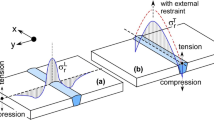Abstract
Over the last decade, as more in-depth understanding of weld residual stresses is being achieved, particularly of their characteristic distributions in pressure vessel and piping components, the residual stress effects on stress intensities at welds are becoming better understood. In this paper, some of the important residual stress characteristics are first identified in the form of either “bending” dominated or “self-equilibrating” dominated types for girth welds. The applicability in other joint configurations in welded structures is then discussed, with a collection of validated residual stress distributions. The characterization of both “bending” and “self-equilibrating” types in residual stress distributions provides a consistent framework for stress intensity factor considerations in either fracture and fatigue assessment. The contribution of weld residual stresses to stress intensities at welds are shown to be in the form of Ksolutions under displacement controlled conditions. The “bending” type residual stresses provide a longer range of influence than “self-equilibrating” type in K solutions. The contribution of “self-equilibrating” type residual stresses to stress intensities is shown to be dominant when crack size is small, while the contribution of the “bending” type dominant for crack size up to a much larger size with respect to wall thickness.
Similar content being viewed by others
References
Dong P., Brust F.W.: Welding residual stresses and effects on fracture in pressure vessel and piping components: A Millennium Review and Beyond, ASME Journal of Pressure Vessel Technology, The Millennium Issue, 2000, vol. 122, No. 3, pp. 329–338.
Bradford R.: Through-thickness distributions of welding residual stresses in austenitic steel cylindrical butt welds, Proceedings of Sixth International Conference on Residual Stresses (ICRS-6), Oxford, United Kingdom, July 2000, pp. 1373–1381.
Dong P., Osage D., Prager M.: Development of weld residual stress distributions for fitness for service assessment, ASME PVP-Vol. 411, Special Topics in Life Assessment, ASME PVP Conference, Seattle, Washington, July 2000, 23–27, pp. 53–64.
Dong P., Rahman S., Wilkowski G., Brickstad, Bergman M., Bouchard J., Chivers T.: Effect of weld residual stresses on crack-opening area analysis of pipes for LBB applications, 1996, ASME Pressure Vessel and Piping Conference Proceedings, PVP-vol. 324, pp. 47–64.
Brust F.W., Zhang J., Dong P.: Pipe and pressure vessel cracking: The role of weld induced residual stresses and creep damage during repair, Transactions of the 14th International Conference on Structural Mechanics in Reactor Technology (SMiRT 14), Lyon, France, 1997, vol. 1, pp. 297–306.
Brust F.W., Dong P., Zhang J.: A constitutive model for welding process simulation using finite element methods, Advances in Computational Engineering Science, Atluri S.N., Yagawa G., eds., 1997, pp. 51–56.
Zhang J., Dong P, Brust F.W.: A 3-D composite shell element model for residual stress analysis of multi-pass welds, Transactions of the 14th International Conference on Structural Mechanics in Reactor Technology (SMiRT 14), Lyon, France, 1997, vol. 1, pp. 335–344.
Dong P.: Residual stress analyses of a multi-pass girth weld: 3D special shell versus axisymmetric models, ASME Journal of Pressure Vessel Technology, 2001, vol. 123, No. 2, pp. 207–213.
Dong P., Hong J.K., Zhang J., Rogers P., Bynum J., Shah, S.: Effects of repair weld residual stresses on wide-panel specimens loaded in tension, ASME Journal of Pressure Vessel Technology, 1998, vol. 120, No. 2, pp. 122–128.
Dong P., Zhang J.: Residual stresses in strength-mismatched welds and implications on fracture behavior, Engineering Fracture Mechanics, 1999, vol. 64, pp. 485–505.
Zhang J., Dong P., Brust F.W., Shack W.J., Mayfield M.E., McNeil M.: Modeling weld residual stresses in core shroud structures, Nuclear Engineering and Design, 2000, vol. 195, pp. 171–187.
Zhang J., Dong., Residual stresses in welded moment frames and effects on fracture, ASCE Journal of Structural Engineering, March 2000, No. 3.
Dong P.: A structural stress definition and numerical implementation for fatigue evaluation of welded structures, International Journal of Fatigue, 2001, vol. 23, pp. 865–876.
Dong P.: Modeling of weld residual stresses and distortions: Computational procedures and applications, WRC Bulletin, No. 455, September 2000, Welding Research Council, New York, pp. 1–11.
Dong P., Osage D., Prager M.: PVRC/MPC long range plan and joint industry project for weld residual stress characterization and local post-weld heat treatment, Pressure Vessel Research Council, 2000.
Dong P., Hong J.K., Cao Z.: A mesh-insensitive structural stress procedure for fatigue and fracture analysis of welded structures, 2001, doc. IIW-XIII-1902–01.
Dong P. et al.: Finite element and experimental study of residual stresses in a multi-pass repair weld, WRC Bulletin, No. 455, September 2000, Welding Research Council, New York, pp. 22–28.
Author information
Authors and Affiliations
Rights and permissions
About this article
Cite this article
Dong, P., Hong, J.K. Fracture Mechanics Treatment of Residual Stresses in Defect Assessment. Weld World 48, 19–27 (2004). https://doi.org/10.1007/BF03266428
Published:
Issue Date:
DOI: https://doi.org/10.1007/BF03266428




